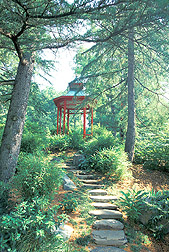| 
Click image for caption and other photo
information.
|
Tallying the
Trees in the Nation's Capital
By Alfredo Flores
September 11, 2002 The
U.S. National Arboretum has done more
than its fair share, over the years, to help beautify Washington, D.C. But this
past summer, the arboretum took an unusual step to ensure that the nation's
capital remains beautiful. Arboretum staff sponsored the
Garden Club of America's Casey Trees
Endowment Fund in a grassroots effort to inventory the city's trees.
The arboretum is administered by the Agricultural Research Service, the
U.S. Department of Agriculture's primary
scientific research agency.
Using a team of 500 people, Casey Trees completed its goal of counting all
of the trees in Washington by Aug. 15. The team comprised 35 college interns
from all over the country, with major areas of study ranging from landscape
architecture to urban forestry; 22 D.C. high school students; 338 citizen
volunteers; 90 people from area businesses and 15 Casey Trees staff members.
Workers measured each tree's height and diameter, assessed its health,
determined its species and identified spots where trees are missing and where
new ones could be planted.
The arboretum played a special role in inventorying Ward 5, the section of
the city that the arboretum calls home. Jim Adams, curator of the
National Herb
Garden, led what he dubbed "Team Arboretum," a group of arboretum
staff, volunteers, Ward 5 citizens and neighborhood high school students. The
training taught the 55-member team the logistics of a proper inventory, as well
as identification of trees, insects and diseases.
In addition to Adams, the arboretum's Scott Aker, integrated pest management
(IPM) coordinator and acting leader of the arboretum's
Gardens Unit, and arboretum
botanist Kevin Tunison served on the Casey Trees advisory board and provided
training and technical support for the project. Now that the inventory is
complete, data entered on a status map show which trees need to be pruned or
removed, which have Dutch elm disease or are otherwise damaged or hazardous,
and where empty tree boxes are located.
Casey Trees is sharing the completed tree census with the District of
Columbia's department of urban forestry. Adams, a Washington resident, hopes
that his work with Casey Trees will help his town one day return to being a
"City of Trees."
|